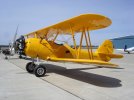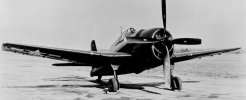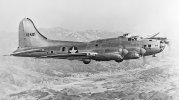-
Please take a moment and update your account profile. If you have an updated account profile with basic information on why you are on Air Warriors it will help other people respond to your posts. How do you update your profile you ask?
Go here:
Edit Account Details and Profile
You are using an out of date browser. It may not display this or other websites correctly.
You should upgrade or use an alternative browser.
You should upgrade or use an alternative browser.
Little known / experimental aircraft
- Thread starter Randy Daytona
- Start date
Sorry…I got ahead of myself! The B in this case is for Beechcraft. They shared the B with Boeing.You are confusing “purchasing and supply” nomenclature with duty nomenclature. In this case…
S = Scout
N = Trainer
B = Bomber
The other interesting product of the Naval Aircraft Factory in Philadelphia was the modification of the Consolidated PBY Catalina designed PBN-1 with revised tail surfaces and bow turret.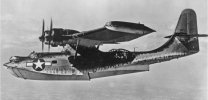
Virtually all PBN-1s were transferred to the Soviet Union under Lend-Lease. The revised vertical stabilizer was incorporated into the PBY-6A,
the final variant of the Catalina.

Virtually all PBN-1s were transferred to the Soviet Union under Lend-Lease. The revised vertical stabilizer was incorporated into the PBY-6A,
the final variant of the Catalina.
Last edited:
My favorite quote about the F7F was that it was "like flying two Bearcats strapped together."You forgot the F7F Tigercat! In this case it was a model that was ahead of its time but just behind the future. One test pilot called it “the best fighter I’ve ever flown.” The Marines used it effectively but it was quickly passed over for jets and angled carrier decks. Interesting side note…in the “pre-woke” era the initial name for the aircraft was the “Tomcat,” but the navy thought the name to be a bit sexually suggestive so it was changed…but the F-14 used the name without much complaint.
The limited carrier trials were a bit problematic; there were a couple of wing spar failures
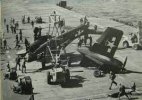
The "C" series Pratt & Whitney R-2800 was ready by mid-1944. 200 more rpm (2800 rpm for takeoff) and extra power. It was installed in the Vought F4U Corsair to make the F4U-4 and in the Grumman F6F Hellcat to make the F6F-6, in both cases with a four-blade prop instead of three. Then the decision was made under the pressure of war production to change the F4U line over to the -4 but retain the "B" series R-2800 for the F6F. I believe only two F6F-6s were converted from -5s and the improved-performance Hellcat was not pursued. No doubt BuAer wanted that hot F6F production line to stay hot.
Attachments
The Douglas XTB2D Skypirate was a proposed replacement for the Devastor torpedo bomber. Too large for the Essex class, it was designed for the Midway class carrier. Power came from a Pratt & Whitney R-4360 Wasp Major driving contra-rotating propellers. (and the number on those piston engined Pratt’s was the number of cubic inches) A huge wingspan of 70 feet allowed it to takeoff from a carrier with 2 torpedoes, or from land with 4 torpedoes. The war ended while it was still in an experimental stage.

 en.m.wikipedia.org
en.m.wikipedia.org

 www.thedrive.com
www.thedrive.com
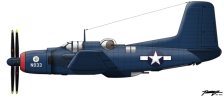
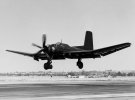

Douglas XTB2D Skypirate - Wikipedia

The Colossal Skypirate Was A Beast Of A Carrier Aircraft Design
With 70 feet of wingspan and a 22 foot high tail, the Skypirate was the huge piston powered Navy torpedo bomber that never came to be.


I’ll dig around, but I think one of these is for sale on the warbird market.The Douglas XTB2D Skypirate was a proposed replacement for the Devastor torpedo bomber. Too large for the Essex class, it was designed for the Midway class carrier. Power came from a Pratt & Whitney R-4360 Wasp Major driving contra-rotating propellers. (and the number on those piston engined Pratt’s was the number of cubic inches) A huge wingspan of 70 feet allowed it to takeoff from a carrier with 2 torpedoes, or from land with 4 torpedoes. The war ended while it was still in an experimental stage.

Douglas XTB2D Skypirate - Wikipedia
en.m.wikipedia.org

The Colossal Skypirate Was A Beast Of A Carrier Aircraft Design
With 70 feet of wingspan and a 22 foot high tail, the Skypirate was the huge piston powered Navy torpedo bomber that never came to be.www.thedrive.com
View attachment 38509
View attachment 38510
Nope…I saw an AF-2S Guardian…big and ugly but not the same big and ugly!I’ll dig around, but I think one of these is for sale on the warbird market.

9995Z | 1949 GRUMMAN AF 2S on Aircraft.com
Find 9995Z 1949 GRUMMAN AF 2S on Aircraft.com. View photos, ownership, registration history, and more. Aircraft.com is the leading registry for planes, jets, and helicopters.
That ain’t natural.The Boeing XB-38 was a B-17 with the Wright R-1820 9-cylinder radials replaced by Allison V-1710 liquid-cooled V-12 engines. Just one was built in 1943. It was slightly faster than the B-17 but the ceiling suffered.View attachment 38595
In the words of Bill Murray, sort of like dogs and cats living together.That ain’t natural.
Speaking of unnatural, how about the late-WW2
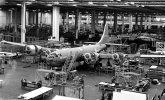 XB-39: A B-29 with eight(!) liquid-cooled V-1710s, paired together and designated V-3420. I'm unable to find a photo of this aircraft in flight, but here it is under construction.
XB-39: A B-29 with eight(!) liquid-cooled V-1710s, paired together and designated V-3420. I'm unable to find a photo of this aircraft in flight, but here it is under construction.Should have been called Spirit of FrankensteinIn the words of Bill Murray, sort of like dogs and cats living together.
Speaking of unnatural, how about the late-WW2 View attachment 38597XB-39: A B-29 with eight(!) liquid-cooled V-1710s, paired together and designated V-3420. I'm unable to find a photo of this aircraft in flight, but here it is under construction.
hlg6016
A/C Wings Here
In the words of Bill Murray, sort of like dogs and cats living together.
Speaking of unnatural, how about the late-WW2 View attachment 38597XB-39: A B-29 with eight(!) liquid-cooled V-1710s, paired together and designated V-3420. I'm unable to find a photo of this aircraft in flight, but here it is under construction.


